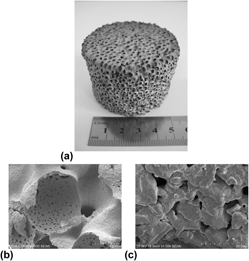Article contents
Characterization of the electromagnetic shielding and compressive behavior of a highly porous titanium foam with spherical pores
Published online by Cambridge University Press: 26 October 2015
Abstract

A novel sort of cellular titanium foam with the porosity of 86–90% and the main-pore size of 0.5–3.0 mm was successfully prepared. Such foam exhibited a compressive curve showing three regimes: the initial elasticity, the middle zigzag plateau, and the final “densification.” This “densification” presented a course that the broken pieces continually accumulated in those pores which were unbroken or not entirely broken. The fracture morphology suggested that the compressive failure was typically brittle for this titanium foam. The electromagnetic shielding performance was investigated in the radio wave frequency range (0.3–3000 MHz) for this foam, which showed an evident effectiveness with a good performance at low frequencies. On the whole, the effectiveness would be superior while the porosity of the sample was relatively small. It could be inferred that the present foam samples would perform their electromagnetic shielding mainly by the reflection loss mechanism in the low-frequency range, and give priority to the absorption loss mechanism at the upper-frequencies.
- Type
- Articles
- Information
- Copyright
- Copyright © Materials Research Society 2015
References
REFERENCES
- 11
- Cited by


